A hugely surprising win by Chinese athlete Shuangyan Hao in the women’s class and an even more surprising third place by Li ZhuoYe (also CHN) in the men’s class was the big headline at the World Cup final Sprint in Songtang, China on Sunday. This was the first ever Sprint World Cup race organized in China, and as expected the Chinese could offer an excellent area for sprint orienteering.
The men’s class was won by Yannick Michiels (BEL), 2 seconds ahead of the third big surprise of the day – French Maxime Raururier, with Li ZhuoYe another three seconds behind. In the women’s class Swiss Simona Aebersold finished 10 seconds behind Hao in second place with Sarah Hagström (SWE) in third. The big favourite in the women’s class, Tove Alexandersson (SWE), did big a huge one minute mistake at the start of the race, and lost the battle against Hao already to control 3.
Men: Consistent race by Michiels while others missed
Although the course may not look that challenging on paper, the intensive orienteering in narrow alleys in Songtang required high concentration on nearly every leg, making it very difficult to be ahead of the game and take the right decision in every crossing. Very few came through the course without mistakes – many of the top favorites losing 10-15 seconds in one or more places. Michiels did however keep his focus all the way in the tricky parts and used his speed reserves in the more runnable parts towards the end of the course. Looking at the split times, Michiels was behind Chinese ZhuoYe until the second last control, but the finish speed secured him the victory and similarly Rauturier got the second place due to his (even higher) speed.
Here is a split browser of additional runners, where you can see the mistakes of Kral, Hadorn and Hubmann who ruined their chances for a top placement. More details about where the mistakes happened below.
Note: The men’s course is uploaded to SPAS – all athletes who ran the race are encouraged to find their name on the list and add their routes. Sorry, no SPAS for the women – focus is on the men’s course this time.
The course started with some intriguing orienteering in narrow alleys. There were some routechoices at these first few legs, but it was more about good mapreading skills and fast running in narrow alleys in this first part than about routechoices. Several runners lose significant time here – Kasper Fosser for example 12 seconds already to control 1 – the Swedes Andren and von Krusenstierna 17 and 20 seconds to control 1.
To control 3 some runners lost time on routechoices (A/B are the best, C loses you some 5-15 seconds, D even more), notably one of the big favourites Vojtech Kral took the C-route and lost 14 seconds. Also other good sprinters like Martin Regborn and Andreas Kyburz did the same routechoice miss here.
Also to control 4 several runners lose time; some like Lucas Basset take a wrong routechoice and lose 15-16 seconds (Basset takes C). Other like Daniel Hubmann (+17 sec) and Florian Howald (+16 sec) run the correct route (A), but run into a wrong alley and have to run out again. Joey Hadorn and Tim Robertson also lose 10-12 seconds here.
The leg to control 5 is the first real routechoice leg – nearly half the field and quite a few of the top runners want to take the opportunity to relax the head a bit and go out towards the water front (B or C), losing 8-10 seconds to (A). Matthias Kyburz and Tim Robertson are two of the top runners doing this mistake.
At the TV leg left (A) is slightly faster, but no big time differences.
We do have interesting results at the first TV-control, though. Double China in the lead – and even a 7 second gap from the leader down to the first non-Chinese runner is not what one would expect based on earlier race results.
| 1. | Li ZhuoYe | China | 3:25 | (+0:00) | Total: 15:23 (3) |
| 2. | Xiyuan Liang | China | 3:28 | (+0:03) | Total: 16:48 (41) |
| 3. | Tuomas Heikkila | Finland | 3:32 | (+0:07) | Total: 16:58 (45) |
| 4. | Gustav Bergman | Sweden | 3:32 | (+0:07) | Total: 17:16 (53) |
| 5. | Maxime Rauturier | France | 3:34 | (+0:09) | Total: 15:20 (2) |
| 6. | Tobia Pezzati | Switzerland | 3:35 | (+0:10) | Total: 15:52 (11) |
| 7. | Yannick Michiels | Belgium | 3:36 | (+0:11) | Total: 15:18 (1) |
| 8. | Gaute Hallan Steiwer | Norway | 3:36 | (+0:11) | Total: 15:31 (4) |
| 9. | Joey Hadorn | Switzerland | 3:36 | (+0:11) | Total: 16:01 (15) |
| 10. | Albin Ridefelt | Sweden | 3:38 | (+0:13) | Total: 15:46 (10) |
The leg to control 7 starts getting really interesting, though. Here a late change of the course (partly due to the incident at CISM; new information from the Senior Event Advisor says this was due to construction and not the CISM incident, but changes would have been considered if not for the construction work) introduced an extra forbidden area making it necessary to go back out of the control to take the best route (A). Many runners missed this, including the Chinese runner Xiyuan Liang in second place who lost 18 seconds on running the B-variant here. Other runners running B includes Fosser (+13 seconds), Hadorn (+14), Tranchand (+14), Svensk (+14), Smithard (+16), Regborn (+28). Some even start with B and then jump over to A (Hubmann +14, Bergman +19)
Not too much action to control 8 (although some runners like Basset manage to lose 15 seconds here), but control 9 is an interesting routechoice leg. Here A or B is definitely fastest with many runners taking non-optimal routes. Of the top runners most take the right choice, but for example Vojtech Kral (+36) and Gustav Bergman (+31) lose their chance for a top result here; Kral would have been in 4th with an optimal route here. Bergman’s route is not easy to see from the GPS.
The leg to control 10 is another routechoice leg. This time left (B) is clearly faster, and again several top runners take the wrong choice. Notably winner Michiels loses 8 seconds by going to the right and second placed Maxime Rauturier loses 20 seconds(!) on a route to the right.
Then we have some controls with less routechoices, but some of the top runners still lose time on every leg – telling us that orienteering in this area requires full focus to see each alley you have to run into.
The next interesting leg is the leg to control 13. This would normally be a quite simple leg – you just have to see on the map that you need to get out to the bigger alley (A or B). Several however don’t study the map carefully enough and start off straight – and then they still have to go out to the big alley after losing valuable time. Notably second placed Maxime Rauturier again takes a wrong choice and loses 15 seconds – Hadorn loses 23 seconds – both on a C-type variant.
The next control where you can lose time due to wrong routechoice is control 17, although the GPS does not tell too much of the story here. We note again that Gustav Bergman loses significant time (+16), and this time also Matthias Kyburz (+17) – it might look like they choose the risky F-choice? Third placed ZhuoYe also loses 12 seconds here, but it looks like this is more about running than routechoice.
To 18 we have the last routechoice leg of the race – with straight (A) clearly being the fastest. Several runners including winner Michiels run all the way around to the left – a route which is around 8-10 seconds slower.
Women: Victory for Shuangyan Hao
In the women’s class everybody was talking about Tove Alexandersson winning all World Cup races this season – but in the end Alexandersson was not even close after a big mistake to the third control. The GPS-tracking does not tell much about what actually happened, but Alexandersson got lost in the small alleys, losing her chance to get historical with all World Cup wins in a season right here at the start of the race:
Looking at the graphical split times, we see how Alexandersson gets closer and closer after her mistake – probably running with high risk to try to get back the lost time – but then does another miss to control 15 (the same as the men’s 17th) and is really out of it. Simona Aebersold does a similar mistake to control 15, and this is actually where Hao decides the battle for the victory against Aebersold.
Looking at the 15th leg, Hao actually loses 6 seconds here as well, not taking the optimal route of Sianoja to the left. Alexandersson takes the same route as Bergman in the small river – both getting wet and losing a lot of time. Aebersold lets down her guard in the runnable part of the course and does a “beginner mistake”.
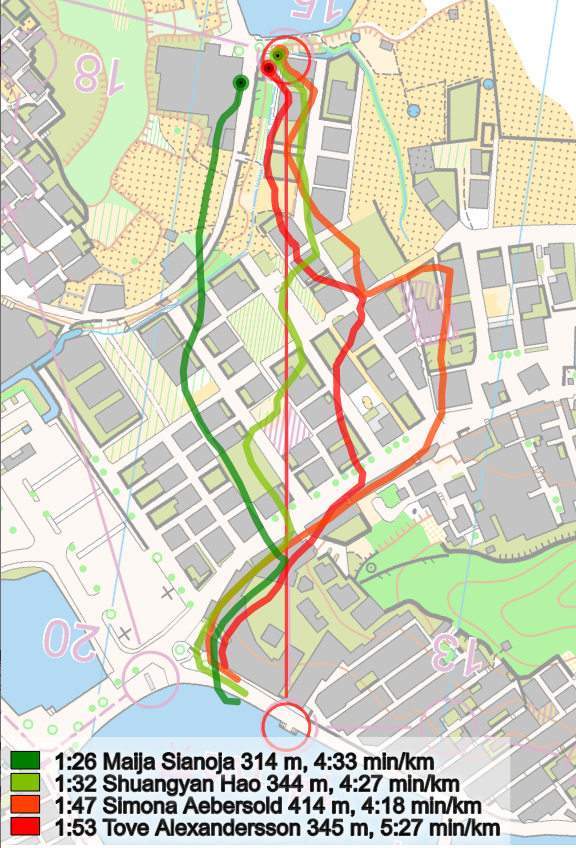
Another decisive leg is the leg to control 16 (the men’s 18th leg); here Sarina Jenzer loses her chance for a place in the top 3 with a long route to the right, while Sara Hagström wins her place on the podium with a great time on this leg.
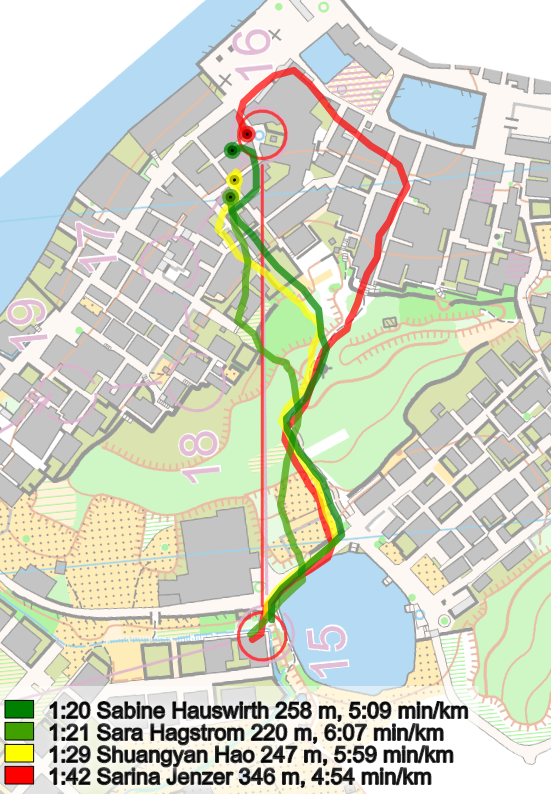
Also notable is Elena Roos’s mistake to the 6th control where she loses the chance for a place at the podium (along with a mistake at 16 where she does the same as Jenzer):
Chinese top results at the World Cup: Too good to be true?
The big question after the race was the related to the fantastic Chinese results. Especially with the CISM scandal just behind us: Chinese runners were according to the International Orienteering Federation disqualified for massive cheating (later modified to withdrawn) at the CISM Middle distance race after equally fantastic results as at the World Cup Sprint: Winning the women’s class with 6 minutes and finishing only some seconds behind Matthias Kyburz in the men’s class.
So how do the Chinese results at the World Cup hold up against a video, GPS- and split-time analysis? Let’s start with the men: Looking at previous results at top level, the Chinese men starting at the World Cup have no top results from earlier – there has not even been a man starting at WOC sprint for many years and the best result in WOC Sprint from a Chinese man is a 49th place from 2001. ZhuoYe who took 3rd place at the World Cup in China finished 58th at the Switzerland World Cup Sprint a month ago.
Unfortunately there is according to the TV broadcaster no TV footage available for the Chinese runners as they started before the TV broadcast, and thus it seems like the analysis must be done based on splits and GPS-data only (if anybody has video footage, please notify me and I will update the article accordingly). The GPS-data can mostly be used to assess which routechoice the runners took. In this regard the answer is positive as seen from the Chinese runners side: Looking at the three best men, the runners did take different routes at many of the legs, both in the technical part and on the longer legs. Thus there is at least no indication that they based on prior knowledge of the course knew the best routechoice on each leg and had pre-memorized this route.
Looking at the split times, there is a very clear pattern as to where the best Chinese men gain most time on their competitors: On the technical legs which require lots of map-reading. If you take away all the legs where it is more about running than about intensive mapreading (including “just” running after choosing a routechoice on a longer leg), the Chinese men are extremely impressive. Below is a result list of the 13 most map-reading intensive legs (removing leg 6, 7, 9, 10, 14, 17, 18, 21-finish); this result list gives double China on top and three Chinese runners within Top 5.
| 1. | Li ZhuoYe | China | 6:44 | (+0:00) | Total: 15:23 (3) |
| 2. | Xiyuan Liang | China | 6:46 | (+0:02) | Total: 16:48 (41) |
| 3. | Yannick Michiels | Belgium | 6:47 | (+0:03) | Total: 15:18 (1) |
| 4. | Maxime Rauturier | France | 6:56 | (+0:12) | Total: 15:20 (2) |
| 5. | Tang JianDa | China | 7:03 | (+0:19) | Total: 16:10 (22) |
| 6. | Max Peter Bejmer | Sweden | 7:03 | (+0:19) | Total: 16:27 (32) |
A hugely impressive effort by runners who have never performed within Top 40 in the World Cup before. Looking at the rest of the course, we are back to close to normal (except for the “new” French runner at the top) – with the best Chinese down in 15th place.
| 1. | Maxime Rauturier | France | 8:24 | (+0:00) | Total: 15:20 (2) |
| 2. | Joey Hadorn | Switzerland | 8:24 | (+0:00) | Total: 16:01 (15) |
| 3. | Jonas Egger | Switzerland | 8:25 | (+0:01) | Total: 15:44 (6) |
| 4. | Florian Howald | Switzerland | 8:25 | (+0:01) | Total: 15:45 (7) |
| 5. | Gaute Hallan Steiwer | Norway | 8:26 | (+0:02) | Total: 15:31 (4) |
| 6. | Daniel Hubmann | Switzerland | 8:28 | (+0:04) | Total: 15:45 (7) |
| 7. | Andreas Kyburz | Switzerland | 8:28 | (+0:04) | Total: 15:52 (11) |
| 8. | Yannick Michiels | Belgium | 8:31 | (+0:07) | Total: 15:18 (1) |
| 9. | Isac von Krusenstierna | Sweden | 8:33 | (+0:09) | Total: 16:07 (19) |
| 10. | Eric Borjeskog | Sweden | 8:35 | (+0:11) | Total: 16:05 (18) |
| 11. | Lucas Basset | France | 8:36 | (+0:12) | Total: 16:02 (16) |
| 12. | Kasper Fosser | Norway | 8:37 | (+0:13) | Total: 15:45 (7) |
| 13. | Albin Ridefelt | Sweden | 8:37 | (+0:13) | Total: 15:46 (10) |
| 14. | Ralph Street | Great Britain | 8:37 | (+0:13) | Total: 16:04 (17) |
| 15. | Li ZhuoYe | China | 8:39 | (+0:15) | Total: 15:23 (3) |
| 16. | Matthias Kyburz | Switzerland | 8:39 | (+0:15) | Total: 15:43 (5) |
| 17. | Tim Robertson | New Zealand | 8:41 | (+0:17) | Total: 15:56 (13) |
| 18. | Emil Svensk | Sweden | 8:41 | (+0:17) | Total: 16:14 (26) |
| 19. | Eduardo Gil Marcos | Spain | 8:42 | (+0:18) | Total: 16:16 (28) |
| 20. | Tobia Pezzati | Switzerland | 8:43 | (+0:19) | Total: 15:52 (11) |
Thus, again there is no clear indication that the best Chinese men had previous knowledge of the course (at least not some of the central routechoice legs), and they are clearly not as fast as the World’s top orienteers when it comes to running in the more runnable parts of the course. Their major skill based on this analysis is moving fast in very technical urban terrain which requires a lot of map-reading, i.e. typical Chinese city terrain with narrow alleys like here. Is it possible to master this skill so well without performing well at e.g. the World Cup in Switzerland? Difficult question to answer – and definitely easy to just say no. However, it may be possible to train very dedicated on this skill and get to a high level with the terrain available in China. And to exploit the home advantage to show this kind of results. But it is easy to understand that there is a shadow of doubt over these results; it would definitely have been very good to see some additional top results from these runners, especially when we have the CISM incident just behind us…
In the women’s class the situation is totally different. The best woman Hao is a very fast runner – and is equally good on the short technical legs and on the longer legs. Actually Simona Aebersold is fastest when we look only at the technical legs – 3 seconds faster than Hao. So Hao actually wins the race on the longer legs.
| 1. | Simona Aebersold | Switzerland | 6:37 | (+0:00) | Total: 13:28 (2) |
| 2. | Shuangyan Hao | China | 6:40 | (+0:03) | Total: 13:18 (1) |
| 3. | Tereza Janosikova | Czech Republic | 7:05 | (+0:28) | Total: 13:49 (5) |
| 4. | Sarina Jenzer | Switzerland | 7:05 | (+0:28) | Total: 13:57 (6) |
| 5. | Sara Hagstrom | Sweden | 7:06 | (+0:29) | Total: 13:34 (3) |
| 6. | Julia Jakob | Switzerland | 7:06 | (+0:29) | Total: 13:47 (4) |
Thus the pattern we see among the men does not fully repeat among the women. We have also seen good results from Hao earlier (although her 10th place at WOC sprint is from back in 2009). But she has been regularly in the sprint finals at WOC, and has also a 13th place from WOC Sprint 2012. A jump from top 10 to the top with a big home advantage and full focus on these races is not that unprobable, although Hao has not shown top results for some years.
An isolated World Cup win by Hao without any CISM incident and top results in the men’s class would have been celebrated as a fantastic surprise for Chinese orienteering – now however there is unfortunately for Hao a shadow over the result until she can show similar great skills again. Let us hope we will see both Hao and the other Chinese runners competing in Europe as soon as possible, showing the world that they truly have reached a higher level …
Maps and GPS tracking
See the men’s map at the top of the article and the women’s map below. GPS-tracking from TracTrac is available at this page. Note also again that the men’s course is uploaded to SPAS – all athletes who ran the race are encouraged to find their name on the list and add their routes. For others this is a great way to learn more about the race decision points.
Results
Men
| 1 | Yannick Michiels | 15:18 | 3:49 | ||
| 2 | Maxime Rauturier | 15:20 | +0:02 | 3:50 | |
| 3 | Li ZhuoYe | 15:23 | +0:05 | 3:50 | |
| 4 | Gaute Hallan Steiwer | 15:31 | +0:13 | 3:52 | |
| 5 | Matthias Kyburz | 15:43 | +0:25 | 3:55 | |
| 6 | Jonas Egger | 15:44 | +0:26 | 3:56 | |
| 7 | Florian Howald | 15:45 | +0:27 | 3:56 | |
| 7 | Kasper Fosser | 15:45 | +0:27 | 3:56 | |
| 7 | Daniel Hubmann | 15:45 | +0:27 | 3:56 | |
| 10 | Albin Ridefelt | 15:46 | +0:28 | 3:56 | |
| 11 | Tobia Pezzati | 15:52 | +0:34 | 3:58 | |
| 11 | Andreas Kyburz | 15:52 | +0:34 | 3:58 | |
| 13 | Tim Robertson | 15:56 | +0:38 | 3:59 | |
| 14 | Frederic Tranchand | 15:57 | +0:39 | 3:59 | |
| 15 | Joey Hadorn | 16:01 | +0:43 | 4:00 | |
| 16 | Lucas Basset | 16:02 | +0:44 | 4:00 | |
| 17 | Ralph Street | 16:04 | +0:46 | 4:01 | |
| 18 | Eric Borjeskog | 16:05 | +0:47 | 4:01 | |
| 19 | Isac von Krusenstierna | 16:07 | +0:49 | 4:01 | |
| 19 | Vojtech Kral | 16:07 | +0:49 | 4:01 |
Women
| 1 | Shuangyan Hao | 13:18 | 4:09 | ||
| 2 | Simona Aebersold | 13:28 | +0:10 | 4:12 | |
| 3 | Sara Hagstrom | 13:34 | +0:16 | 4:14 | |
| 4 | Julia Jakob | 13:47 | +0:29 | 4:18 | |
| 5 | Tereza Janosikova | 13:49 | +0:31 | 4:19 | |
| 6 | Sarina Jenzer | 13:57 | +0:39 | 4:21 | |
| 7 | Elena Roos | 14:10 | +0:52 | 4:25 | |
| 8 | Tove Alexandersson | 14:11 | +0:53 | 4:25 | |
| 9 | Victoria Haestad Bjornstad | 14:12 | +0:54 | 4:26 | |
| 10 | Maija Sianoja | 14:23 | +1:05 | 4:29 | |
| 11 | Sabine Hauswirth | 14:25 | +1:07 | 4:30 | |
| 12 | Sofie Bachmann | 14:35 | +1:17 | 4:33 | |
| 12 | Lotta Karhola | 14:35 | +1:17 | 4:33 | |
| 14 | Josefin Tjernlund | 14:37 | +1:19 | 4:34 | |
| 15 | Paula Gross | 14:41 | +1:23 | 4:35 | |
| 15 | Denisa Kosova | 14:41 | +1:23 | 4:35 | |
| 17 | Svetlana Mironova | 14:43 | +1:25 | 4:35 | |
| 18 | Jiayi Zheng | 14:46 | +1:28 | 4:36 | |
| 19 | Vendula Horcickova | 14:49 | +1:31 | 4:37 | |
| 20 | Silje Ekroll Jahren | 14:52 | +1:34 | 4:38 |
 World of O News
World of O News
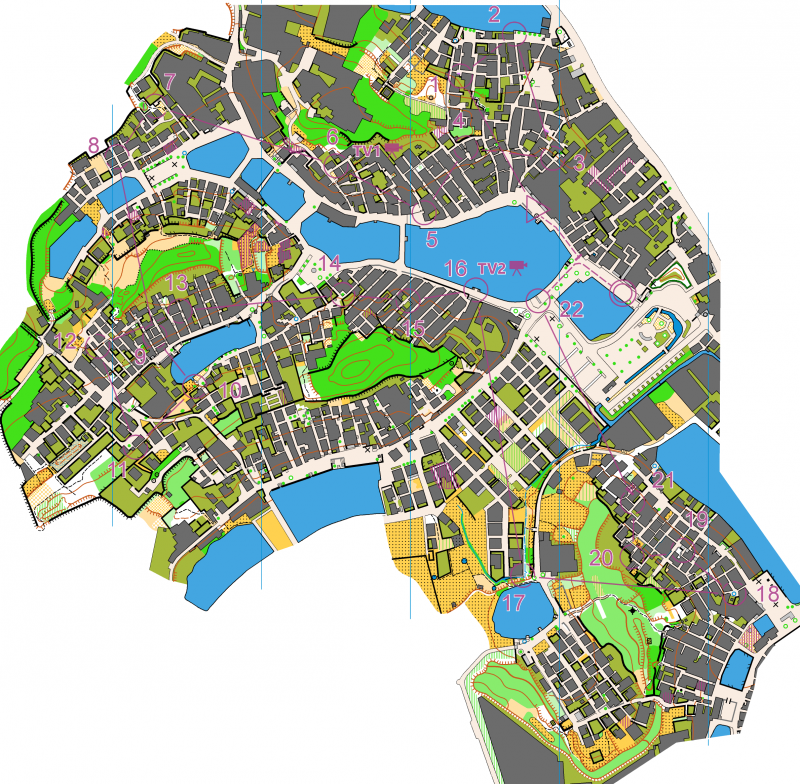
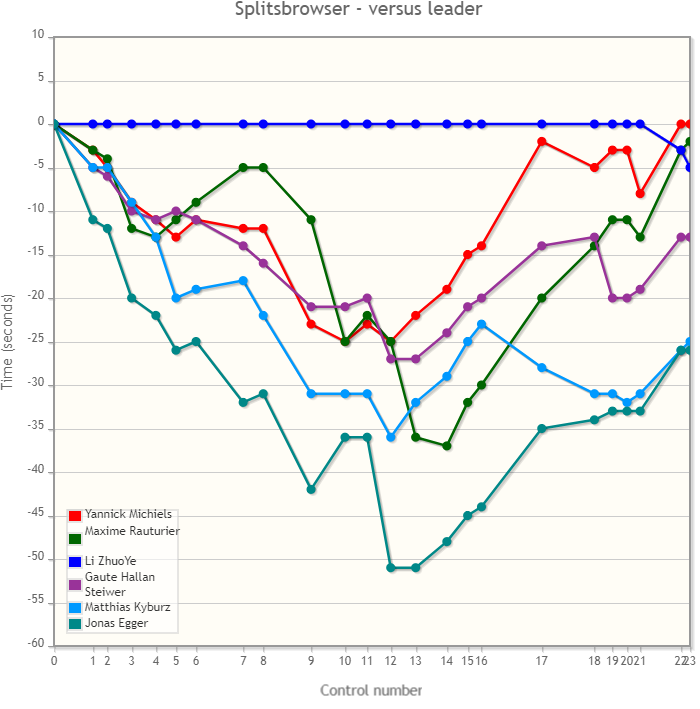
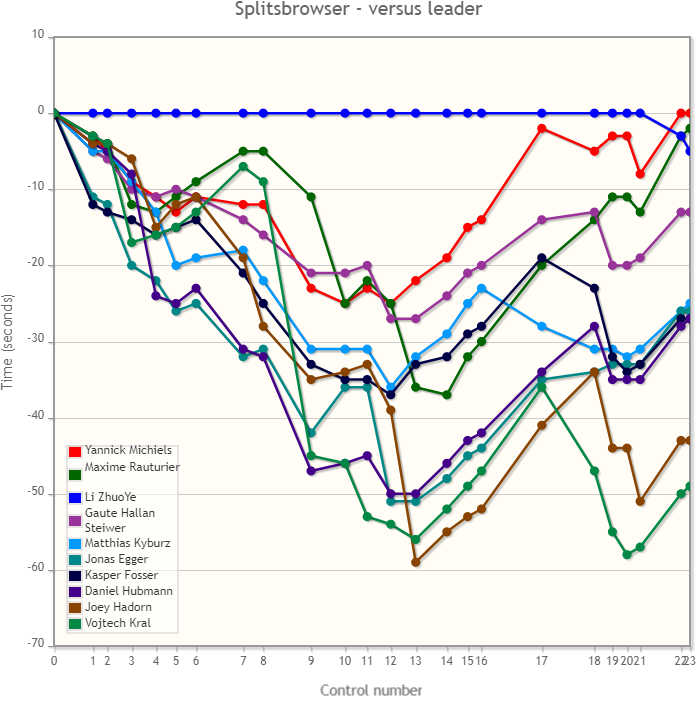







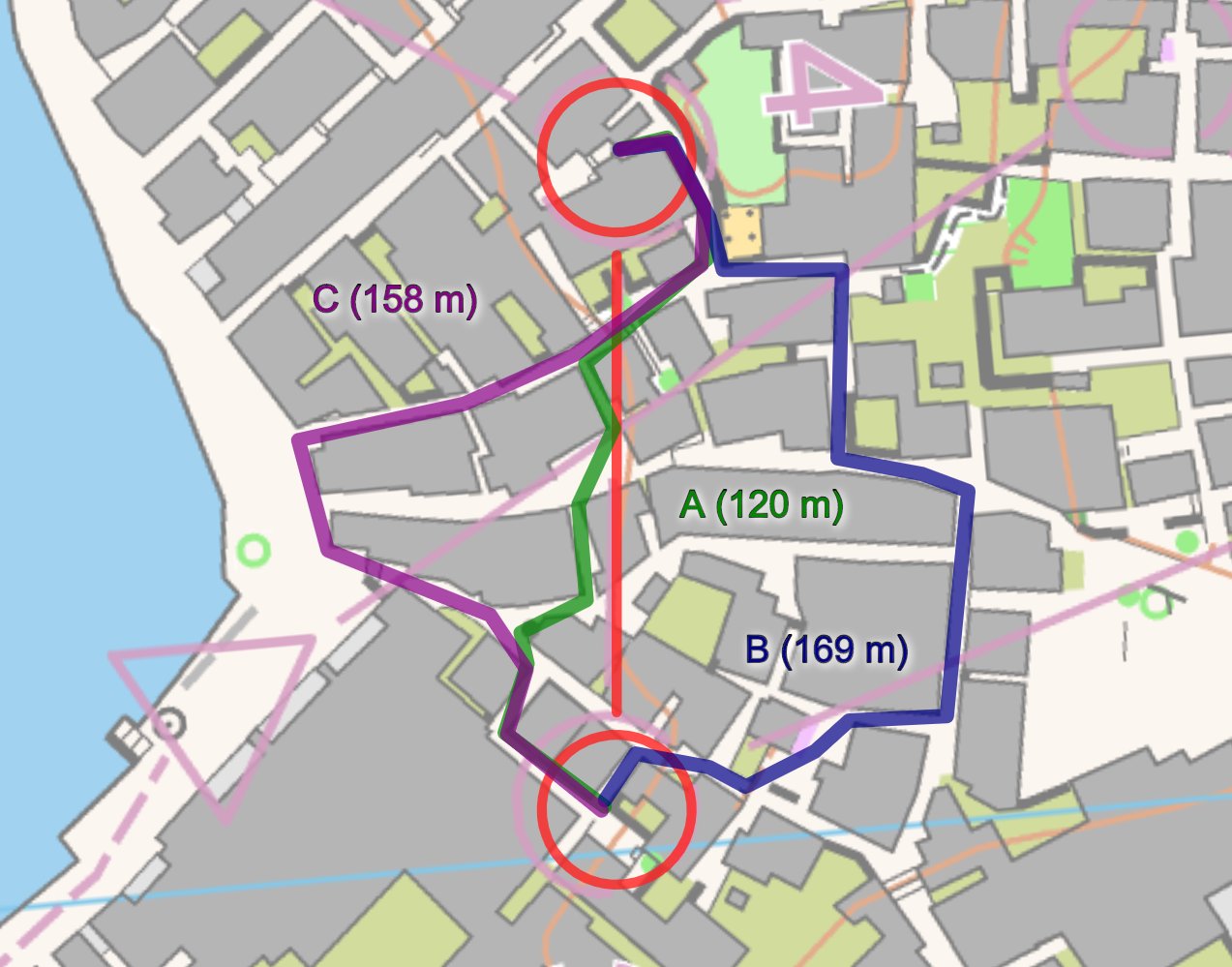


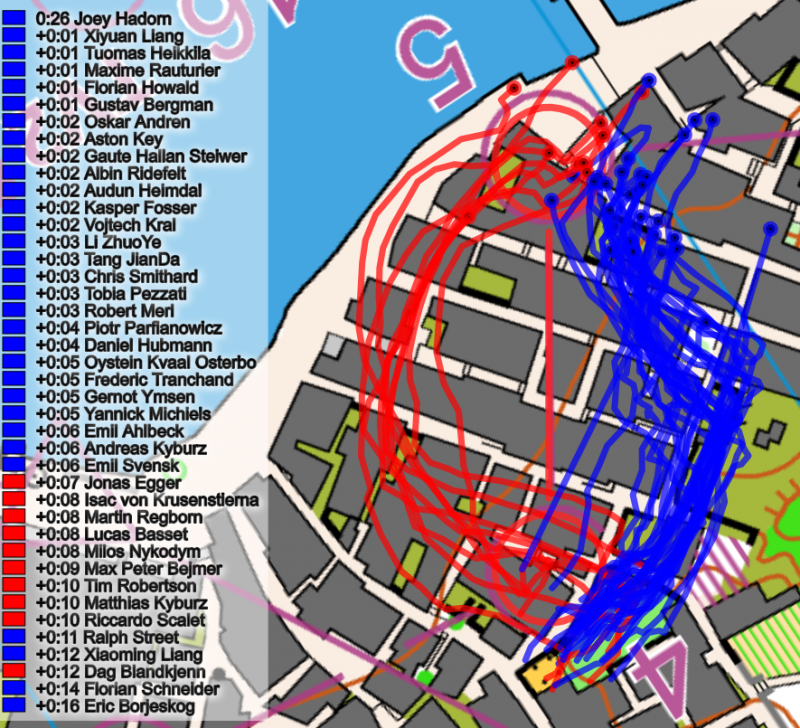







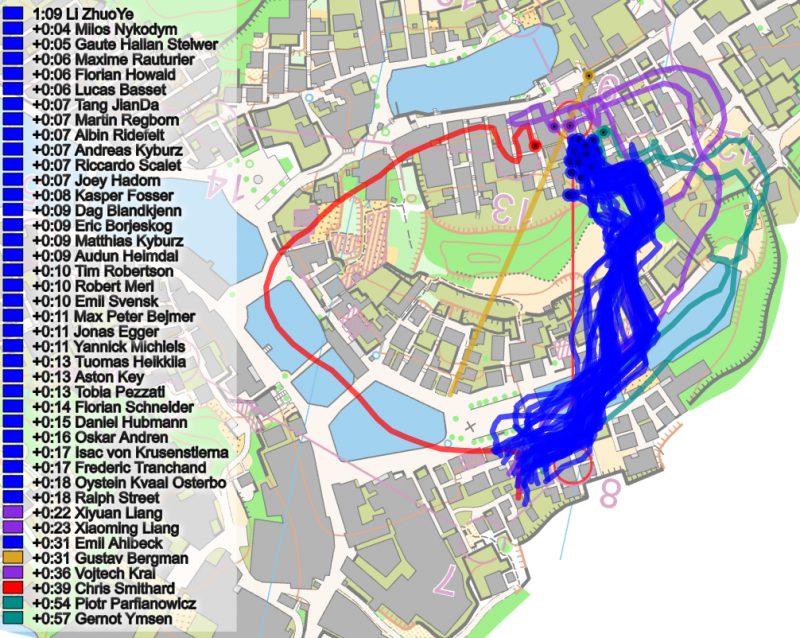


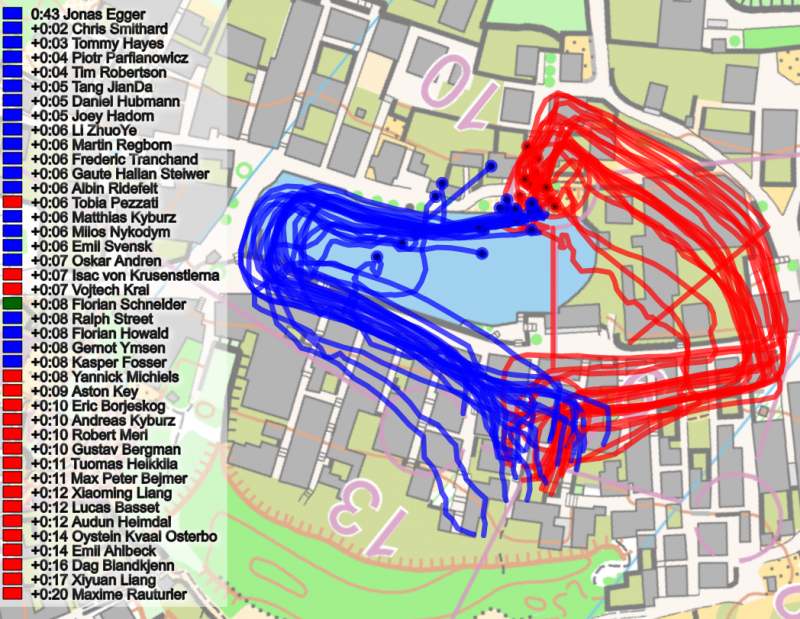


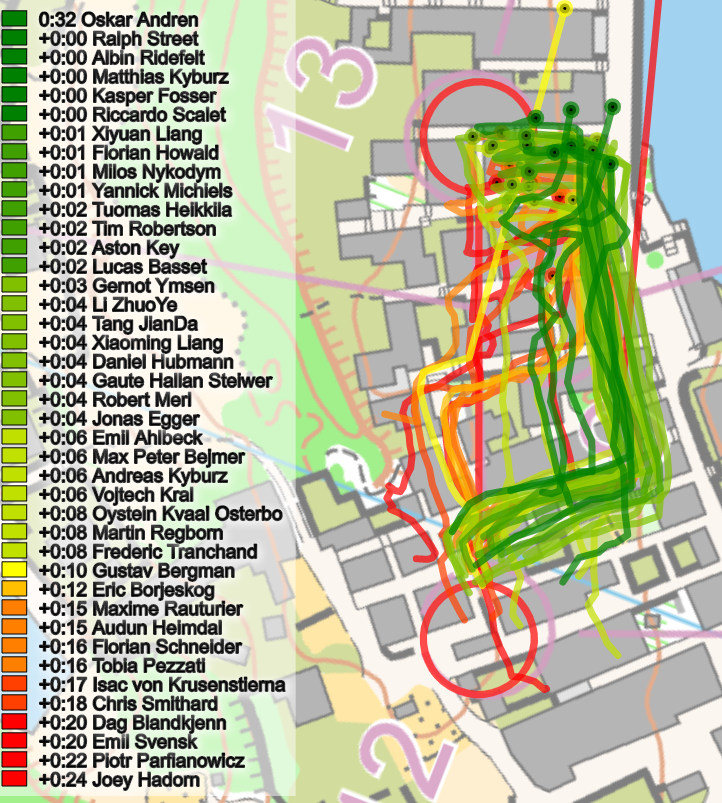


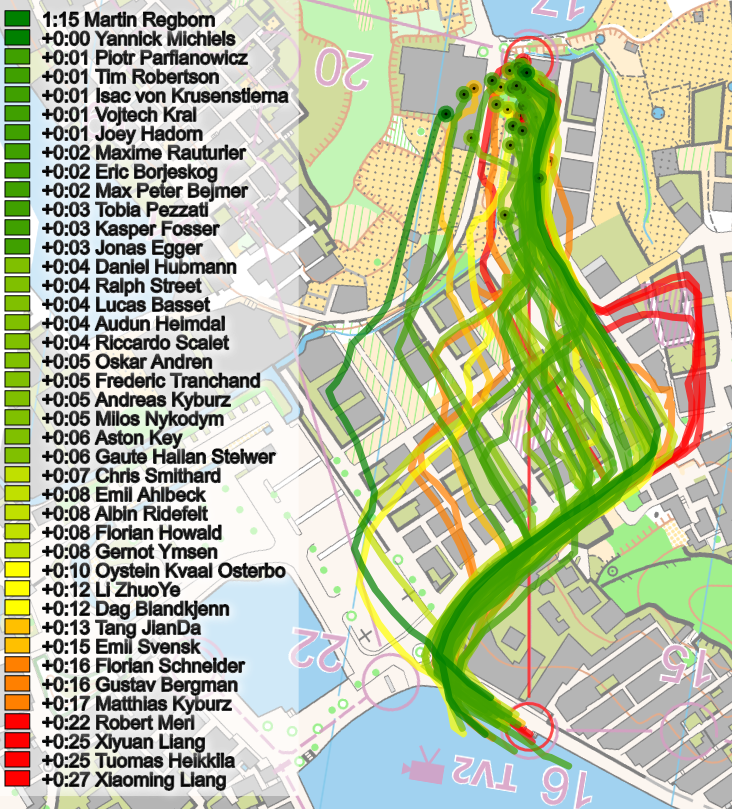


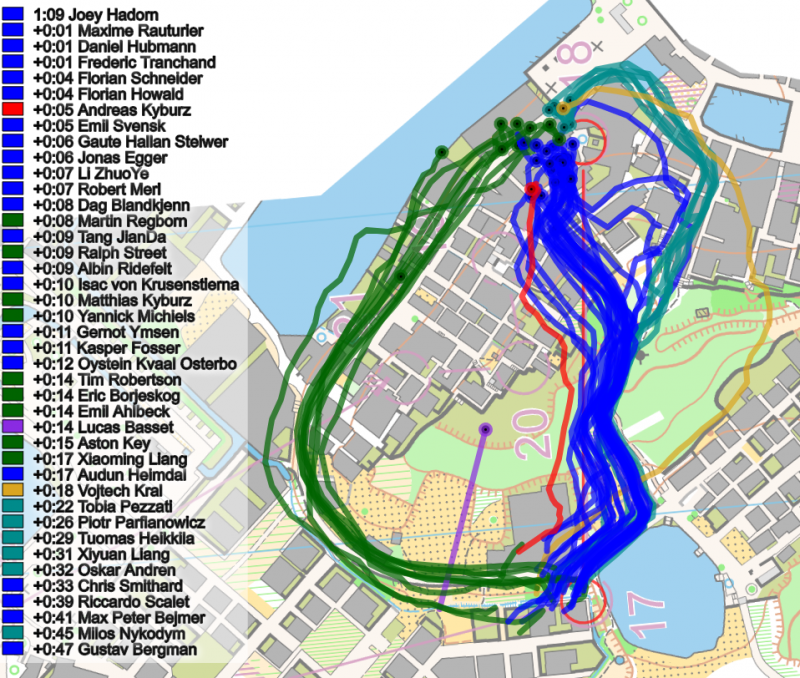
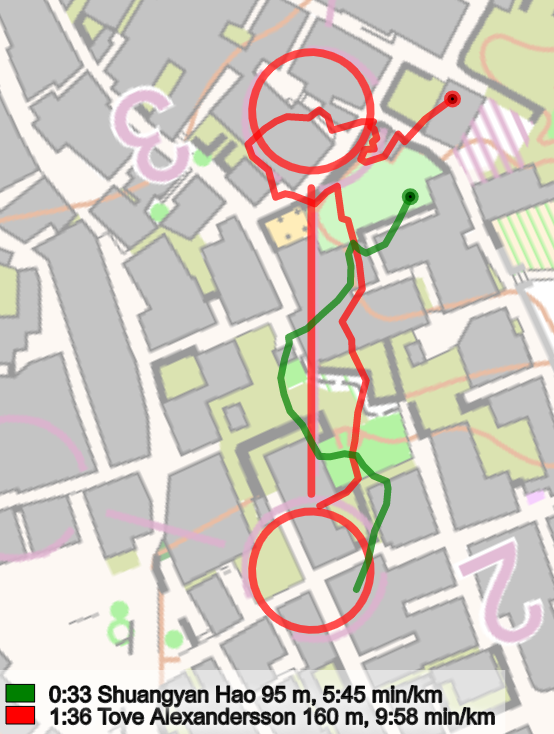
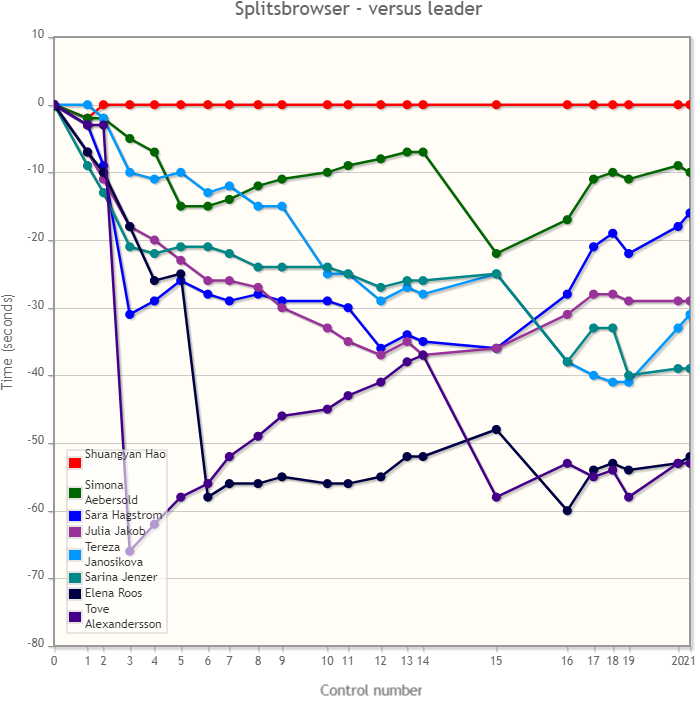
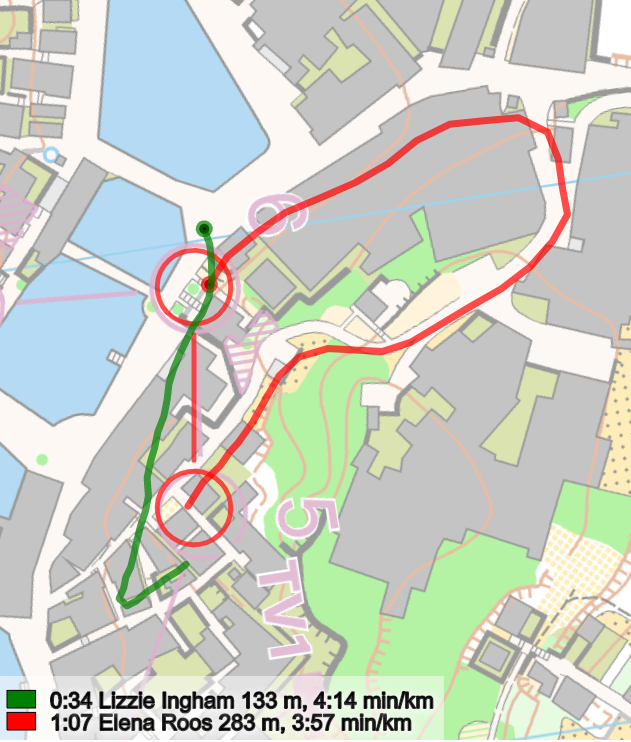
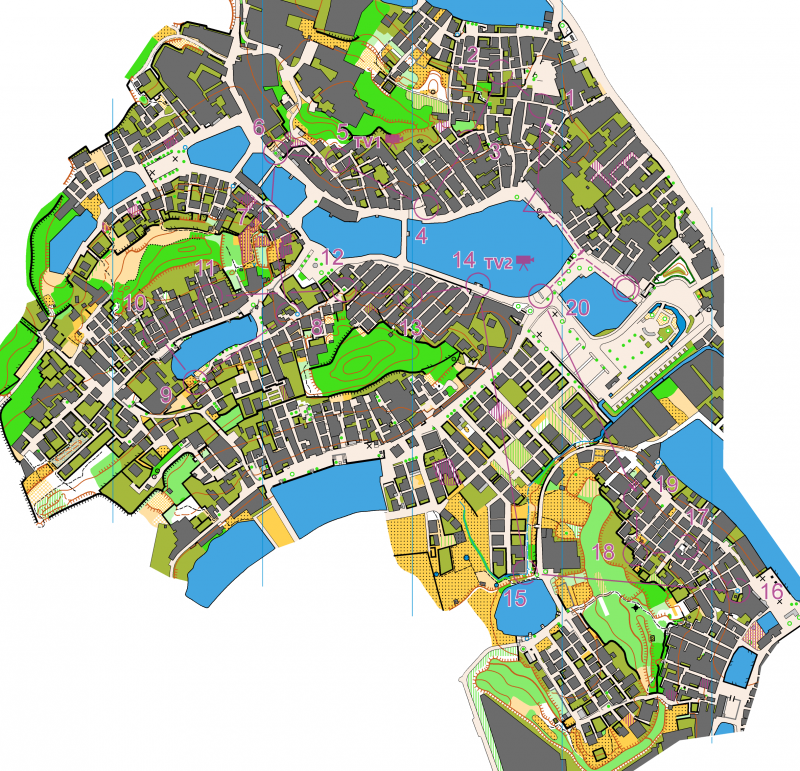
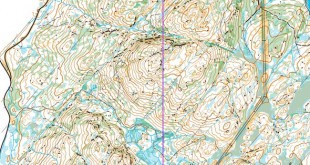



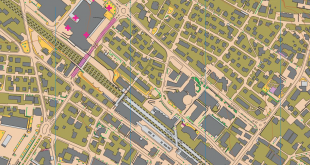
The GPS graphics reached a new level of abstraction during the final World Cup sprint. Usually it’s able to interpret what’s going on for someone already into orienteering, but quite hard for outsiders. This time though it sunk to a level where it became practically useless for everyone. The only thing you could tell from the live synced replays was that somebody was ahead of somebody else, but never really why. A meaningless clutter of disinformation.
Even Jan Kocbach himself has a hard time to make a correct analysis afterwards of what really happened in some stretches of the race and which route choices actually were made by the runners.
The GPS tracking is one of the biggest issues to make the sport understandable and liked by a broader audience. I understand that in this competition the very narrow streets and alleys is the reason for bad transmission. But with that said, TracTrac is still a crappy working platform with poor stability and functionality.
Totally agree!
Thanks for the analysis Jan! Amazing how much cool stuff you accomplish with your hobby-level effort. Agree that it would be great to see some good results from these Chinese runners in Europe to back up these performances. Does it make for a more fair competition having the World Cup Final in Switzerland every year? Not sure sport can ever be 100% fair but let’s hope that willful cheating has not taken place. I remember that Lizzie’s breakthrough World Cup race in NZ when her Dad was a main organiser was universally celebrated and it would be great if we could give these athletes the benefit of the doubt too if there is no evidence of foul play.
This is a really difficult situation and we should be careful to accuse the Chinese for cheating before having more facts. On one side I see the fact that if you have trained a lot in this type of sprint terrain, and possibly grown up in a town like this, you will be much better at interpreting the map, and better to see what is an entrance to an alley and what is just an entrance to a house. This can of course explain why the Chinese have performed better on the sprint yesterday than on sprint races in Europe. However, what then seems strange is why the Chinese haven’t performed better on the PWT-races in China the last years where many of the best runners in the world has been competing.
Another strange thing is the total dominance of the Chinese on the first radio control. In the men’s class the Chinese are number 1, 2, 3 and 4 on the first radio (control 3). On first TV (control 6) they are number 1 and 2 (control 6). In the women’s class they are number 1, 6, 7 and 9 on first TV control (control 6). Many of these runners are totally falling down through the result list later in the course and ending up as 29, 40, 45 and 62. There is very little TV-coverage of the Chinese as most of them were starting early. However, Yong Yu Li, starting 14:13 in the women’s class, was shown. She was number 29 in the end but 7th on the first radio. The video-clip published by Ivar Lundanes on Twitter shows her out from the start. She is reading the map in 4-5 seconds, and then it is just running to the start control and into the alleys: https://mobile.twitter.com/ivarlundanes/status/1189125157161451521?fbclid=IwAR25qeqh2YUrGPLvmunrx5oGqd3ZpFH-36DKjWv2qDArRpNdI5VAZguwBO8
Do you run like that when you are entering an unknown, really detailed and technical terrain?
As Jan also is mentioning, I have heard that IOF made changes to the sprint course after the CISM scandale. But with the arena given and planned TV-production, there was maybe not too much that could be changed. It would be really interesting to know how the original courses looked like.
Well, the optics of that clip (very little map reading and high speed, almost passing the french guy at the starting point) together with her first split times inspires to thoughts about a new level of ”used to the environment” and ”accustomed to the circumstances”.
Oh please, this is more than obvious that they were cheating. Anyone who has seriously trained in any sports event and especially orienteering knows that you can’t make such unexpected jump in performance. It just doesn’t happen. Also after what happened at CISM just few days prior it’s more than obvious.
Urhen – yes, exactly. Come on everybody, skip these European style always positive and searching for explanation cooments and let´s finally realize not every country in the world goes fair play and deserves respect.
I have seen what Li Yongyu did and I knew what you confused about. But the fact is that some elite runners in south China have trained sprint in tricky village terrain many many times and the consequence is we can read the map for a few seconds then we can choose the route in one leg and remember where the first entrance is. I started orienteering nearly 4 years ago and I was addicted to orienteering. In local orienteering event , we usually use village for sprint and the village is more tricky,tough,complex the runners are enthusiastic. After more and more sprint practices or competitions in south China village , we have some very specific skills in these terrain and our own experience about sprint in these villages. So , that’s why we looks like wired in european runners’ opinions. Hope you can understand , thank you .
Thanks for great analysis!
I’m quite sure that a pro in statistics could take some other race data into account and calculate a probability of the Chinese team results to be valid and true. Still miracles happen.. :)
@Karlis: I don’t see how you can do proper statistics on this when you don’t have data. Then you’ll have to do a lot of assumptions of how different the terrain is, how good their preparations have been etc. Even if you put the analysis into a statistical framework, your analysis results won’t be better than your assumptions…
Thank you for a good analysis Jan, as always(!), taking into account the poor gps material you have had at hand. I think the analysis where you distinguish between the most “technical” part and the more “physical” part is very interesting, as one would expect that preknowledge of the technical parts would offer larger advantages compared to legs dominated more by running capacity (even for the best orienteers in the world who are able to maintain a high steady pace through technical parts with many turns). In regards to this analysis I thought of something that might be interesting (but perhaps not possible). Could one to retrieve a histogram of the speed distribution for each runner over the entire course? If so, it would be possible to compare a single runners histogram to the average distribution (among the top20 athletes e.g.) and then make a statistical test to conclude if a certain runners distribution could arise from the average distribution or opposite indicate something fishy.
Preknowledge (or extremely good technical skills;-) would in turn likely lead to a more uniform speed distribution, especially if you only look at the technical parts, compared to a “more poor” orienteer.
I guess it would require some work polishing the gps data fixing it to some routechoices (if that is even possible), and the difference might not be significant after all. Just an idea..
@Marius: I don’t think a quantitative analysis like that would give you much more than this more qualitative analysis. I thought about trying to translate this to running speed, but what kind of extra information would that give you? Yes, you would see that the Chinese generally have lower average running speed compared to their result, but we already know that from this qualitative analysis, and what it boils down to is that they perform better in technical urban terrain. It won’t tell more about this being due to an extremely high general skill-level in this type of terrain or prior knowledge about the terrain/course.
I agree in your point – the chinese runners could just be very good in this very special urban terrain, with small alleys and different architecture compared to european-like urban areas. I find that unlikely through. Assuming that the best sprint orienteers in the world has a very high technical level, working with their skills every day for years, being able to make the best decisions in a very short time span, it seems unlikely that the chinese runners should be so much better technically, just because of the urban structure. At the end of the day, sprint orienteering is perhaps the discipline that requires the least interpretation-wise (map to terrain translation) compared to the forest disciplines, as a road, a building and a wall is more or less the same in every part of the world. It mainly requires fast decision making in two dimensions, finding the shortest route (most often). The video Ivar posted on Twitter looks suspicious to everyone who has a slight idea of what complex sprint orienteering requires, but again that is only one example – she might have made a huge mistake to the first control. The idea with the speed distribution was not to look at an average speed (as the average speed between Michels, Rautaurier and Zhuoye ≈ same), but for instance get an idea of how much time the average strong runner spends running less than
say 8kph compared to a certain runner, in the technical parts of the course.
*Though
Yong Yu Li, featuring in the video, had the second best split time to the first control as well as to the second control. On the next legs she slowed down a little, but she is still number 5 at the 8th control. After that her split results are significantly weaker, except for the two last legs before the arena passage.
Leif >> Haha ok, I did not check the split times, but apparantly she was running with good confidence there :D
Considering the fact that they did different routechoice, can just be a proof that as orienteers they found out a more clever way to cheat and hide it (much more clever than the military way in CISM). Different routechoices, but all of them were «good» (at least not bad), no?
It’s pure speculation, but I would interpret your interesting data that way :
They knew the race so were very efficient in the first part which is technical. One Chinese runner in the top at the 1st radio control would be ok, but almost all of them in front is hard to believe. Even harder to believe as most of them are weaker on the running side, which means they were performing a top technical performance at a higher percentage of their physical ability. Then as the race became easier and also that they get tired (running full speed a «known race» is quite exhausting), they loose time at the end. And as you said, it also seems that they got trouble around the modified area.
Would be interesting to get runners feedback (while out of China…), but don’t really see any reason to believe in it except the presumption of innocence.
IOF SEA Blair Trewin wrote an interesting comment at Nopesport today (http://forum.nopesport.com/viewtopic.php?f=1&t=15659&start=15):
“I think it’s plausible that training happened on the area using old maps – and if you saw the old map, you could probably make an educated guess as to where the arena was, and from there the likely area where the first part of the course would be (but a lot of teams do that these days) – but think it extremely unlikely that the course was leaked (not least because the second half was completely redesigned in the last few weeks before the event, and some fine-tuning such as addition/removal of forbidden areas was happening up until the evening before the event; also, almost none of those who had access to the final or near-final courses were locals, with Jaroslav Kacmarcik as the course-setter).”
First, it’s interesting to see the SEA saying it’s plausible that training have been done in the area (of course, there is no way for IOF to control anything like that, and it’s the same in all countries, you just have to rely on fair play).
Secondly, the second part of the course was changed in the last weeks before the event and we know that the chinese were really dominating the first part where the course seems to be unchanged.
Then you have the new forbidden area between control 6 to 7, where about 2/3 of the Chinese men got that route choice wrong after dominating the first 6 controls.
Third, Blair says “almost none of those who had access to the final or near-final courses were locals”. Well, it only takes 1 to spread information…
My take is that cheating is quite possible in this situation and with the facts we have from results, splits, former performances, Jans analysis and Blair comments I would guess something like this went down:
1. The Chinese team have been training in the area (old map)
2. They had access to early versions of the course
3. They new the course had been changed (but possibly didn’t know what was changed).
The chinese runners are, unlike those cheating at CISM, pretty decent orienteers and know how to handle a map. So they could without any problem see where the changes were made and where there were new forbidden areas they didnt know about beforhand. One could laugh of Li ZhuoYe for beind the 93rd fastest at WC in Switzerland, but he was not more than 2 1/2 minute behind, so he’s a decent sprint orienteer (but the gap from decent to podium is HUGE).
The 3 steps of cheating I mention is possible to do, it fits in with Blair comments of this situation, it fits in with Jans analysis and it should be enough to bring a few lucky decent sprint orienteers into world class sprint orienteers for one day.
Here are a few extra comments from Swedish runners about the event:
https://www.aftonbladet.se/sportbladet/a/e8RKrg/efter-skandalen–nya-kinesiska-skrallar-i-varldscupen
Gustav Bergman about possible ways to cheat: “One way to cheat is to see the course beforehand. I can easily say that I would’ve won if I had access to the course before the race today”
And an interesting comment from Martin Regborn on Strava: “23rd (would have been 21 without the obviusely cheating Chinese.”
Also I want to bring in a few comments from a Chinese guy called Devon Yao on Facebook: “Li Zhuoye is a teacher , he has work and he has not enough time for training himself but he tired his best to do it and it is the best result for him.”
and
“After he became a member in Chinese national orienteering team this year in May , he tried his best to train himself everyday. I’m his friend and we often train together.”
In my opinion, it doesnt make it more believable when you argue that the runner ending up third is working a lot, doesn’t have time for much training, tries to train everyday and just kind of trying his best. A guy that have been half a year with the national team, training a little bit beating guys that have been elite athletes for 5-10 years.
And you also have the comments from Matthias Kyburz on his Facebook page today:
“After two eventful weeks in China I am back home in Switzerland with more than just mixed feelings.
The most basic fairness rules in orienteering got disrespected at the CISM World Games in Wuhan by Chinese runners. First I thought that winning by all means only belongs to the CISM World Games. But after the Sprint at the World Cup Final, I am more than sceptical that the results from the civilian Chinese runners were obtained by following the fair play rules.
I don`t have a clear evidence for their cheating but I know how much effort over years normally is needed to reach the top in orienteering.
I still feel angry and kind of helpless that this happens in front of my eyes.
I want to rise my voice that fair play in our sport always wins!
More to come “soon” on my webpage!”
There is a lot of smoke after this event and normally, where there is smoke there is fire…
Sounds reasonable! And thanks for sharing the video.
If we assume for a moment that the Chinese team didn’t cheat, we can focus on some of the problems of creating a level playing field at orienteering events. Competitors on home turf will always have several advantages, and there are ways to enhance these advantages still further. 1. Cultural advantages; understanding how the type of building, terrain etc. relates to the map. 2. Training/competing on the area before the embargo kicks in. 3. Non-competitors giving feedback about the race areas. 4. Training on similar areas. 5. Obtaining high-quality maps and photos. 6. Having a good idea where the start/finish will be. 7. Knowing the style of the planner.
How to mitigate some of these problems: 2/3. Longer embargoes, and proper checks that embargoes are being adhered to. Unless a race area is kept secret, it’s very difficult to preserve the integrity of the area, and to check that non-competitors aren’t passing on help in the form of gopro videos, etc. But the IOC has a choice: get strict, or never have a fair race. 4. Warm-up events in similar areas, months, weeks and days before the event. tbf there usually are opportunities for competitors to compete on similar areas beforehand, but it can be too expensive to attend these events.
5. All maps and photo sources must be made known to IOC and distributed to other teams. 7. Use planners from other countries; this can make event organisation quite expensive though! At the least, the planners should not be from the local teams of the competitors.
In some ways it’s good that events in far-flung places have some inbuilt advantage for local runners; this will encourage European runners and the IOC to think less Europeanly.
Let organizers always publish the actual map! Before the WC sprint race, we have just really shit map in Bulletin 3 (if you print it – it is not possible to see passages, details, etc.). That is the step in the right direction!
Focusing on something positive I must say I’m very impressed by Simona Aebersold. Already a big name but A Big name for the future.
I’ve already said elsewhere most of my thoughts on what happened. One point of clarification – the very late changes which happened in the sprint (and the sprint relay) were for reasons other than the goings-on at CISM (e.g. late construction), but had those changes not been necessary I think we would have thought seriously about making some anyway. The second half of the sprint course was completely redesigned after the TV people visited in mid-September.
As noted in the comment that Ivar cross-posted, the sprint did have a foreign planner (Jaroslav Kacmarcik).
I would be very interested to see the Chinese in a complex Mediterranean old town sprint; I see the challenges (particularly the sheer number of decisions that have to be made in a short period of time) as being quite similar.
@Blair Trewin – Do you know the courses from September so well that you could tell which legs in yesterdays courses were the same, or very similar, as a leg in the September courses? It could be interesting to compare that information with the split times.
Do we think that next year Danish team will not have any advantage on WOC?
http://tuelassen.blogspot.com/2015/09/woc-sprint-preparations-2015-and-2016.html
By Tue; “I remember a discussion about the course with the Swedish medal-boys after the race. We could discuss routechoices without even having the map. Tue: “To first control, which passage did you take? Søren: “I wanted to take the passage with the wooden fence”, but missed it and took the stairs instead”. Jerker: “I took the passage at the wooden fence”. Jonas: “I went through the passage at Coop”. Tue: “Yeah, I also took the Coop-passage”…
At least the Swedes were well prepared, but I guess that most other WOC-sprinters reading this, know exactly which passages we’re talking about here??
It was also quite funny that almost every time we were in Forres walking around, me met some of the French runners.”
Let´s face it, if Chinese runners used advantage of their home terrain, it is not something what has been done for the first time in orienteering…
I think, with the CISM-incident, it is legitimate to ask the question. However, in the mens division, both Rauturier and Hallan Steiwer are runners we are not used to see on the uppermost part of the leader board in intenational competitions. It is plausible that the technical challenges offered by this course suited their “profile”, and the chinese, being used to this type of terrain, had the home turf advantage. Also lets not forget that many top runners made many significant mistakes. If several of them had cleaner races, we would see more of them in the top.
I really think we should reflect on our attitudes towards these athletes. Isn’t that shear arrogance?
😊
I hope the chinese love their children too.
😊
Nobody seems to talk to them directly, but it is clear that they were highly motivated and welll prepared (the fast start and fast decisions are indications for this) but not all of them were as well trained…
They prepared for this alike everrybody does for World Champs since the introduction of Sprint as a discipline. Learing the terrain by heart, streetview a.s.o.
******** maim argument *******
The main argument against collective foulplay is simply that all chinese runners aside Hao and ZhuoYe made mistakes.
*********************************
Why does nobody question Rauturier,s exploit while it is okay to question the chinese sportmanship collectively?
I think there is a interesting aspect in this story which is that we from the old nations want orienteering to become a global sport but did not imagine that if the sport got global for real we would loose our dominance (to whoever takes orienteering serious).
Watch out for confirmation bias!
What about jet lag or other acclimation factors and lower or variable performance/ motivation at the end of a long season for the Europeans? World Cup Final results have often been a bit weird. We see leaps in performance by non Chinese athletes too. Gaute HS goes from decent to podium because of it being a technical sprint that suits him (and not having done any international sprints lately – also true for the Chinese right?) The training around work comment is a total red herring. There are other examples of top sprint orienteers with jobs.
There are certain details that look fishy but some of this analysis sounds like confirmation bias.
These results are possible. Unlikely but possible. What’s sad is how much people seem to want this to be cheating and seem to be looking for evidence to support what they already believe.
Is there a racial element to this bias? People were super excited about Hanny Allston, Lizzie Ingham and Emily Kemp doing well. Maybe people need to question their own prejudices? Why are people so desperate for these results not to be legitimate?
Helen, sorry to ask, but could it happen that you have fallen for confirmation bias to show that there might be a confirmation bias?
You imply that “leap in performance” by Gaute is on par with that of Li, going from decent to podium.
Gaute in China was #12 on Middle, #3 in Sprint Relay, and #4 on Sprint.
He was #19 on Sprint WCup a month ago, #1 in WOC Relay 2018 (close to it in 2019 too), regularly #15 to #19 on WOC and WCup Sprint for many years. (too many to list)
Li in China was #75 on Middle and #3 on Sprint.
He did not start on Sprint Relay for reasons unknown. Wasn’t he selected as one of top 8 Chinese men?
He was #98 on Sprint WCup a month ago, and #79 in KO Sprint.
Isn’t there a confirmation bias comparing Gaute’s somewhat unexpected good performance of #4 to Li’s most surprising result of #3?
If it looks like a duck, swims like a duck, and quacks like a duck, then it probably is a duck.
It is true though, that there is a possibility that it is not a duck. Unlikely, but possible.
@Helen You say that World Cup finals often have been a bit weird. Wich years are you thinking about? I dont say you arent right, I just cant rember thees weird results.
yes, the last event of the season is about chatting with friends, drinking a few beers and running funny race on a strange map. But usually, you don’t call it the World Cup.
Big congratulations to Shuangyan Hao and also to Li ZhuoYe!
Regarding the good results of SHuangyan Hao in the past and the home advantage (with aspects such as being familiar with the type of terrain until having no jet lag) it was for sure a big success, but not really a surprise that she/You won the race. The main reasons against the win were gone since Maja Alm and Lina Strand were due to injurys no longer entered and Tove Alexandersson did her big mistake to the 3rd control.
Regarding jet lag issues and “foreign disadvantage” it was maybe also not very surprising that Li ZhuoYe did not so well in Switzerland (maybe 79th instead of top40). Especially men who known the very special chinese type of terrain from earlier competions and trainings such as Yannick Michiels, Maxime Rauturier and of course the chinese runners themselves did well. Favorites like Gustav Bergman, Daniel Hubmann and Matthias Kyburz did some or many mistakes.
Thank you Helen for your upstanding! I am also a bit disappointed about all these negative comments. After the CISM world games (maybe different militarys and harmonic sportsmenship are a contradiction) it is allowed to be critical, but this critics were not all based on hard facts. Racism is sadly in the subconscious of europeans nothing special (also I have sometimes these problem I believe), but it is important to be yourself conscious about that and not act only out from your subconscious. For sure many people are absolutely no convinced racists but act sometimes racial.
@Joris – please read my comment further down. Based on hard facts it is clear to me that several of the Chinese runners must have been in the terrain and training in the old version of the course. It is a fact that 7 of the Chinese runners were performing at a top international level in the first part of the course. And then their speed and technical skills suddenly, and at the same place in the course, dropped to a much lower level. How do you explain this? Did the charater of the town suddenly change?
Your additional argument is that the runners from the other nations were suffering from jetlag. There are at least two reasons why this is wrong: (1) It takes one day per hour time difference to get rid of jetlag. At the time of the sprint (Tuesday 29th of October) nearly all the runners had been in China for more than six days. (2) The results on Saturday 26th and Sunday 27th didn’t show any jetlag problems for the foreign runners.
@Leif: If one were to continue at the 800 m world-record pace for 5000 m one would finish at 10:30.69, so it is possible to start too fast to be able to keep the initial pace to the finish.
This is not an argument against possible cheating, it is only an argument proving your argument to be too poor to be used.
I totally agree with Helen!
A 4th place to Gaute Hallan Steiwer is equally suspicious as 3rd place to Li ZhuoYe. It’s not like any of them are both World Champion, Junior World Champion, regularly top 20 in WC/WOC and Norwegian Sprint Champion…
If you look at the Sprint World Ranking it would be less a surprise if:
– The race were held in Belgium, Yannick win with 1:30 and one of Tristan Bloemen and Thomas Hendricx ends up second.
– The race were held in Turkey and Ahmet Kacmaz win.
– The race were held in USA and Giacomo Barbone ends up on the podium.
– The race were held in Romania and Ionut Zinca and Roman Ciobanu goes 1-2.
– The race were held in Ireland and Nick Simonin wins by 40 seconds.
And still, even if these results would give more sense then Li ZhuoYes 3rd place there would for sure be really big speculations if any of them happened…
To be accused for cheating when you haven’t cheated, is even worse than being beaten by somebody who has been cheating. We should generally be careful in this case, and any conclusions should be based on facts.
The CISM-scandal showed, however, massive cheating from the Chinese. The cheating was planned and organized by the Chinese military national team and the organizers. This cheating was at a level of the Russian doping scandal in the Sotchi Olympics and the Lance Armstrong/US Postal case. However, the cheating at CISM was poorly executed so it was detected immediately.
Ivar Lundanes documented that the Chinese team official at CISM also had been team official for the Chinese at WOC, i think at three out of the last five WOCs. (Please apply more details, Ivar). There are in other words links between the military and civil orienteering in China (as everywhere else).
Based on this the Chinese trustworthiness and credibility is close to zero!
And when the surprising results from the Chinese runners in the WC sprint on Tuesday are happening, I think it is the obligation of everybody, who wants orienteering to be a sport where we have fair play and where we can trust each other, to ask critical questions and try to find the facts about what has happened.
And what are the facts that have been gathered so far about what happened in Tuesday’s sprint:
1. The courses were really technical and challenging. The “superman”-time (the sum of all the best split times) in the men’s class was 1:16 better than the winning time. This is much in an international sprint and means that very many runners had the running capacity to win if they had the necessary technical skills and did a really good performance.
2. If you have trained a lot in this type of sprint terrain, and possibly grown up in a town like this, you will be better at interpreting the map, and better to see what is an entrance to an alley and what is just an entrance to a house. This can of course explain why the Chinese have performed better on the sprint yesterday than on sprint races in Europe. Li ZhuoYe have according to Chinese sources grown up in a village like this.
3. In the technical areas in the first part of the course many of the Chinese were running really outstanding. At the 3rd control the Chinese men had the four best intermediate times! At the TV-control (control 6) they are 1, 2, 14 and 25. However, these runners slowed down later in the course. Especially on the easy legs, but in the last half of the course their relative speed is considerable lower also in the technical parts and these runners ended up as number 3, 22, 41, 46, 50. The four best Chinese women were number 1, 6, 7 and 9 at the first TV-control (control 6). In the finish these runners were 1, 18, 29 and 62.
4. Yong Yu Li, starting 14:13 in the women’s class, was shown on the TV-broadcast. She was number 29 in the end but 7th on the first radio. The video-clip published by Ivar Lundanes on Twitter shows her out from the start. She is reading the map in 4-5 seconds, and then it looks like she already knows where the first control is and how to run there. She is just running to the start control and into the alleys without watching the map any more, and she gets second best split time to the first control. At the first control it seems she is already well prepared for the second leg as she has the second best split time here as well.
https://mobile.twitter.com/ivarlundanes/status/1189125157161451521?fbclid=IwAR25qeqh2YUrGPLvmunrx5oGqd3ZpFH-36DKjWv2qDArRpNdI5VAZguwBO8
5. Previous results. The Chinese runners have never had results close to this in any WOC or WC. It can be argued that these competitions have mainly been arranged in Europe where the terrain is different. However, I have never noticed that the Chinese runners have performed at a similar level at the PWT sprints in China either. If anyone has information about the opposite, please let me know.
6. About the course: The course is said to have been changed a lot since the version which existed in September. The first part is the same, but the last half is totally re-designed. The forbidden area on the leg just after the 1st TV-control (control 6 in the men’s course and 5 in the women’s) is also new.
So, what to conclude from these facts? If we shall trust that the Chinese did not cheat, we must believe that:
– In this kind of terrain there must be a huge advantage to know the terrain type and understand how the houses and alleys look like and how it is mapped.
– Many of the best Chinese runners must be really bad at pacing strategy as they are starting way too fast and getting tired and losing their speed and technical capabilities before half way in the course.
– The best Chinese runners must be extremely good technically. They mastered the technical first part of the course even when they ran at a higher speed than they could keep the whole course.
On the other hand you could also believe that:
– The CISM scandal shows that China has a culture where cheating is accepted, planned and organized at national team level.
– It is totally improbable that the four best men and four best women from China could have the positions 1, 1, 2, 3, 3, 4, 5 and 5 at control number 3, and position number 1, 1, 2, 6, 7, 9, 14 and 25 at the first TV-control if these runners weren’t really familiar with this specific area and/or course in this first part of the course. We are not only talking about Shuangyan Hao and Li Zhuoye who mainly kept the speed to the end, but 7 other runners who are obviously at a lower level and in the finish ending up as 18, 22, 29, 41, 46, 50 and 62. These runners are both losing their speed and technical capabilities in the last 2/3 of the course. That all these runners could run at a top international level in the first part of the course, and then collapse simultaneously in the second part cannot be explained in any reasonable way. Maybe two or three runners can do that, but not seven at the same time.
– It is not an accidental coincidence that many of the Chinese are running at an extraordinary level in the part of the course which is the same or similar as the version from September, and then much worse in the second half which was totally re-designed. This coherence indicates that the Chinese in some way have got an early version of the course, and they have been training in the terrain and in this course.
For me this is a very strong indication that at least some of the Chinese runners in some way had access to the early version of the course and have been training in the terrain.
I see one big difference between this and for example Lance Armstrong, and even partially Russian doping (less in this case). When Armstrong was finally sentenced to give back all titles, etc. – US media was full of that. When China cheated – all of their webpages, their radios, TV, etc.never ever mentioned that. All what they mentioned is that they did all perfectly, correctly, etc., they just wanted to say this was the best WC ever organized. They will never ever accept any mistake, and that is the biggest problem for any orienteering/business/environment issues out there…
It would be interesting make an “improvement estimate” of the Chinese runners on the first half of the course, and compare them with the improvements we se on reruns, for example, in the Norwegian sprint league this year. Are they comparable?
You don’t have a good enough reference to do any such analysis, I think. Comparing with World Cup races in Switzerland wouldn’t be fair; I would expect them to perform a lot better in China than that. So you would have to estimate/guess how good they would be in China, and their answer to that question would be to just look at the results now, I guess ….
What has been experienced in the reruns is that the runners of course cut their running time with their time losses due to errors. In addition they are running about 3-7% faster (dependent on the technical skills of the runner and the technical challenges in the course) because they avoid hesitations, run straighter lines and can focus on pushing harder physically.
You can easily estimate the time gain by rerunning a sprint, just by calculating the time difference between a Swiss elite sprint test and the re-run, at 06.04.19 published here
https://www.o-l.ch/cgi-bin/results?type=rang&year=2018&event=WRE+-Testlauf+Sprint
https://www.o-l.ch/cgi-bin/results?type=rang&year=2018&event=Testlauf+Sprint+Rerun
The time gain is around 1.30 in the mean, on a course of 15′ winning time. At least 1′ for almost everybody. What this means for the results in sprint, you can check yourself.
(Drawback of the test for the comparison of the running performance in city-sprints: The athletes were allowed to choose a new, and faster route for the Re-run, if the wanted. BUT this makes it more comparable with the present situation, where athletes were apparently allowed to test the course beforehand (as almost always in cases of doping/cheating: without any doubt, but without any proof, as with Usain Bolt, who ran more than two tenths (2% !!!) of a second faster than a certain Ben Johnson)
Compare the (at least) 10% time gain of a rerun with the reported performance-gain with microdoses of EPO (2-3%, what is technically almost unmeasurable because of imprecisions of performance testing tools)
If you accept, that doping (and any kind of cheating) is almost never the result of a single “clever” individual, “cheating a little bit”, but is almost always the result of a more or less organized network as its prerequisite, one can only be “a little bit concerned” about the current developments.
Who gave the Chinese runners the maps? Who looked away, when they did their training? How much did the huge tomatoes cost, that must have been put on the eyes of some officials (especially after the CISM)? Please forget the ridiculous discussions about supplements and asthma spray…
While the debate and analysis goes on about the world cup sprint and the results of it, I’m curious about the already settled and concluded cheating at the preceding CISM middle distance. The event and the wrong doings are described in many media, but in very general terms. Is there anybody having more details on the subject? What shortcuts were actually made and how were they marked or guided to? How was it discovered and determined? Photo documentation? Maps?
In my opinion, the large number of orienteering errors made by many top level European orienteers compared to the errors made by HAO or Li Zhuoye is not consedered here sufficiently!
The truth is, that Tove and Simona made big mistekes, which are not common to them, and as a result lost the race to HAO. – Also most of the top European male orienteers, whom we are used to see on podium, made orienteering errors, and were to be found much lower on the results list than what they are capable of. Perhaps its time for many to look at the mirror.
The Chinese had less expectations and made use of this situation by clean runs in the terrains where they felt comfortable. – The report above by Jan Kocbach clearly explains this very well. Jan also explains that often the route choices taken by the Chinese, were not similar or optimum, which means that they cannot be proved to have some prior knowledge of the routes.
In this kind of events, if one (IOF?) wishes to ensure the equal opportunities for all competitors (i.e. to avoid the use of prior knowledge of the sprint terrain etc.), perhaps a number of articifial fences may/should be used! – Now on the map there were some restricted areas, but the use of artificial fences delivers a completely different idea!
If you have a leak of the map with the course artificial fences are not gonna work! Cheaters will run the course by the actual best trajectory several times and gain a lot by doing this. And it is extremely difficult to avoid the leak of the map and the course because you have to involve local organizers (in one way or another). And even access to the high-quality map (not the shit quality map available to other teams) and location of start and finish gives a real advantage!
A very interesting development: the IOF President referred the World Cup case to the Ethics Panel (earlier only the CISM case was referred to the EP):
“[…] members in our community and orienteering friends globally were surprised by race developments and final results. Incredible improvement of technical skills and running speed of some athletes creates questions and we, the IOF, need to analyse the background for such unexpected performances from a few athletes. Our sport is based on three values – Inclusive, Sustainable and Ethical. There are understandable doubts that maybe some of our basic values were ignored by some athletes.”
https://orienteering.sport/fair-play-and-major-events-in-new-orienteering-countries/
I had my experience with the Ethics Panel this year when my blog was reported by the IOF to the Panel. You may read the details of the case in this and some previous posts:
https://iofreflections.blog/2019/07/07/ethics-panel-found-no-solid-ground-to-prosecute-this-blog/
In short: the The Ethics Panel launched an investigation despite not being able to identify a single specific comment to investigate, and despite they knew that they had no right to investigate a journalistic activity. After 8 months they could not find a single statement or fact in my post that required correction, or could have been used as a basis for formal action. Hence, a formal process was never launched after the IOF’s complaint. There is no record of this case on the Ethics Panel web page either:
https://orienteering.sport/iof/governance-and-organisation/ethics-panel/
My legal adviser referred to the overall process as “funny”. He particularly enjoyed that the reputable Ethics Panel demanded “clear factual evidence” to allegations they could not even specify. He also found professionally interesting that the Ethics Panel asked the IOF for factual evidence only 7 months after the initial complaint by the IOF – and then it never revealed the details of those apparently convincing facts. I think that process was more than sad.
Let’s hope that this time the Ethics Panel reaches a more specific conclusion, in much shorter time, and in a more transparent process.
Let us keep in mind what Leif Størmer said above: “To be accused for cheating when you haven’t cheated, is even worse than being beaten by somebody who has been cheating.” Let us not forget that Chinese athletes are real people with real emotions and it must feel very, very bad to be accused of something terrible that you have not done, especially when it is not clear how you can prove that you are innocent. So I personally think that even if there is a 1% chance that they have not cheated, we should be very, very careful and give them the benefit of the doubt. As I understand, many of the Chinese athletes are very experienced and train hard, it’s quite possible that the total amount of training is similar to that of the best European orienteers, it’s just that their experience is limited to China. Let us ask ourselves: how can the Chinese athletes prove that they are honest? Running well in European competitions is not a valid answer, in my opinion, because those are different kinds of terrains. Would asking them publicly to reveal more about their training and preparations for this race help convince people one way or the other if they respond? Also, I think it’s worth reading this – https://www.facebook.com/lwybmx/posts/931127123935244 – just saw the link posted on Attackpoint.
It is possible to prove your innocence by downloading tracks to Strava or make a public status of Garmin/Polar trainings since August. Then it will be clear: “I have trained twice per day in different locations but not in the embargo area”.
Polygraph is an option as well. Successful performance in Mediterranian towns (with similar tricky terrain) will show a lot as well about true capabilities. So there are some ways to clear the reputation.
The CISM cheating explanations don’t make a lot of sense:
If you check the split times of the female “winner”, she ran a close to perfect race, so having nearly invisible markers in the forest, hikers/spectators pointing the way, extra paths on the map etc does not explain that performance. In those situations you would see very varying performance from leg to leg.
Using Occam’s Razor it is a lot more likely that they simply had gained (were given?) access to the map and course beforehand and ran through it a few times.
Re. “the culture of cheating” explanation: China has at least 500 years of tradition where all public jobs/positions were dependent upon gaining good results in official examinations where most of the questions depended upon rote memorization, but afaik the actual amount of cheating here might have been less than in India. What is interesting is that they do expect that all possibilities to cheat will in fact be used!
I’ve been competing against two of the best Australian orienteers of my generation for the past 40 years. They are Geoff Lawford and Warren Key. In the past 30 years, I am almost always at least 50% slower than both of them. At the WOC 2014 public sprint-type race in Venice my time was 10% slower than Geoff and 20% slower than Warren. Orienteering in Venice, like the World Cup in China, is characterised by frequent changes in direction. I didn’t cheat.
Why was my performance so much better in Venice? It’s because I perform best on sprint legs that have many twists and turns and do not need any terrain technique.
The Women’s first control was relatively simple, I would not have spent more time reading my map out of the start triangle than Yong Yu Li does in the video clip. The Men’s first control was significantly more difficult.
In the current IOF World Sprint Rankings, the top two Chinese men and three Chinese women have scores from the recent World Cup in China and from other events. Their ranking points in the Chinese World Cup are not radically better than their scores from other events.
There has been at least one surprise home country winner of a World Cup race in the past – Alistair Landels, New Zealand 1994. His win was celebrated and still is.
Numbers are sometimes quite useful:
* In Switzerland Li ZhuoYe finished 58th in B-final (93rd of all competitors), 2:21 down on Yannick Michiels and with an average pace of 3:57 min/km.
* In China Zhuoye finished 3rd, 5s down on Yannick with an average pace of 3:50 min/km.
If we look at the splits in Winsplits with the conditions for a mistake set to 0.05 / 5% (normal is 0,20 / 20%, which means with these settings you should be able to spot even very small mistakes) you see that Zhuoye made 5 seconds of mistakes during his run in Switserland. Even with settings 0.03 / 3% he only have 9 seconds of mistakes during that race. Which means he performed a pretty clean race and he’s still more than 2 minutes down.
In China Winsplits gives Zhuoye 18 seconds of mistakes with conditions 0.05 / 5%, but those times comes on the longer legs to 17 and 22 where he just can’t keep the speed up. With 0.03 / 3 % Winsplit adds an additional 4s “mistake” on the pretty easy 14th leg.
For Yannick Winsplit gives 0 error time even on conditions 0.03 / 3% in Switzerland and 5s of mistakes on same conditions in China (which I think deserves some applause for showing pretty damn stable sprint technical performance!!), which means the splits showing Yannick did a pretty clean race in China but probably had less top 3 splits than normal because he showed the ability to slow down when needed to avoid risks.
So back to average pace. In Switzerland, with a almost perfect race, Yannick managed an average pace of 3:22 min/ km. In China, with what seems to actually be an almost perfect race, his speed dropped to 3:49 min / km.
Then look at a few other runners to get more reference data (conditons for mistakes are set to 0.03 / 3%):
Maxime 45th in Switzerland with 57s of mistakes, average pace 3:44
Maxime 2nd in China with 45s of mistake, average pace 3:50
Gaute 23rd in Switzerland with 0s of mistakes, average pace 3:38
Gaute 4th in China with 12s of mistakes, average pace 3:52
Kasper 7th in Switzerland with 18s of mistakes, average pace 3:31
Kasper 7th in China with 23s of mistakes, average pace 3:56
Clearly, everyone slows down quite much in China compared with Switzerland, which is quite understandable when you see the maps. I looked at the gps-tracks (which in China demanded a bit of imagination as the gps-data looked a bit weird) and came up with the following numbers:
In Switzerland Yannick made about 78 distinct changes in running direction. In China Zhuoye made about 103 distinct changes. In China there were also clearly more “full turns”, while the curves in Switzerland genereally were smoother (this sentence was bad, my English is not good enough to find the right words) and thereby faster. In Switzerland the whole course went on hard surface or nice grass areas. In China there were a few parts where one could assume running speed would be lower (im thinking of leg 8-9 and 17-18). I don’t think there is a huge difference in meters of climbing, but it seemed to be maybe a little bit more climbing China. So in general, it’s fair to assume that people would slow down quite a bit in China compared to Switzerland.
But then back to what I started this post with. In Switzerland Zhuoye ran an almost perfectly clean race and his pace was 3:57 min/km. In China he ran 3:50 min/km. So even if he ran without mistakes in Switzerland, he ran the more tricky and slower course in China with a FASTER average pace. Everyone else naturally slowed down, but his speed increased on a more technical and slower course. That is pretty amazing!
(Fun thought: By this logic he should struggle to run below 4 min/km on an athletics track, you know, a track would not be tricky enough for him to get up to speed :) )
Also including the Qualification for the Knockout Sprint in Switzerland
In heat C Zhuoye was 27th of 38th finishing 1:18 down on Ralph Street. Street were 42s behind Superman in this heat, which means Zhuoye were exactly 2 minutes behind Superman. This was on a course where the winning time were 10:23, which means Zhuoyes qualification time would mean a time about 3 minutes behind Superman if the qualification would’ve been 15 minutes (at the sprint in China the winning time where 15:18). That is really a lot, when Winsplits only give him 16seconds of mistakes with the conditions 0.03/3s (which should catch almost every small mistakes).
At the normal sprint in Switzerland Zhuoye were 2:21 behind Yannick and 2:46 behind Superman. Winning time was 13:29, which meand Zhuoy would’ve been about 3 minutes behind Superman on a 15 minute race. And this race he did almost perfectly clean, with only 9 seconds of mistake (0.03/3%).
So both races in Switzerland (which the splits shows he executed well technically) shows Zhouyes level to be about 3 minutes behind Superman on a race with winning time on 15 minutes. Then in China he’s only 1:21 behind Superman, which is an improvement of about or more than 1 1/2 minute!
I’m a little surprised by the claim that Yannick did not make any mistakes. Another analysis shows that even without the Chinese runner he is far behind superman http://o-zeugs.blogspot.com/2019/11/wc-final-china-without-chinese-athletes.html. In fact there is not a single high level sprint where the winner is further behind superman http://o-zeugs.blogspot.com/2019/11/running-far-behind-superwoman.html.
It seems clear to me that the main surprise is not that Zhouye was doing well on home ground, but that almost everybody else were performing rather poorly.
Looking into Bulletin 1 for the event the previous map of the area is available. This is from 2016 and looks very much like the map used (and obviouslyold city centres like this doesn’t change much).
Zhouye would have had half year to legally study the map and prepare for everything the course planner could dream up.
Some years ago I interviewed a few of the best Chinese runners and their coach. The runners in the group did two hours map studies together with the coach each day.
To me this seems like a runner (or should I say runners) who have realized that this might be their best or only change of an international result, and prepared way better than anybody else.
Some comments on the “benefit of doubt” of doubt mentioned above a couple of times. It was asserted that “even if there is a 1% chance that they have not cheated, we should be very, very careful and give them the benefit of doubt”
Based on consultation with my legal adviser, sport law practice is different from the above assertion.
CAS, the Court of Arbitration for Sport, uses “comfortable satisfaction” as applicable standard of proof in AD cases. One may argue that the suspected cheating in its nature was similar to doping: a premeditated and organised effort to give athletes an advantage through preparation that circumvents the rules, a kind of information-doping.
“Comfortable satisfaction” is not well defined, but according to CAS “the application of the comfortable satisfaction standard is a constant one, but inherent within that immutable standard is a requirement that the more serious the allegation, the more cogent the supporting evidence must be in order for the allegation to be found proven.”
In any case, “comfortable satisfaction” is somewhere between “beyond reasonable doubt” (applied in criminal cases, say 90% proof) and “on balance of probabilities” (applied in some civil proceedings, say 60% proof). Comfortable satisfaction is unavoidably relying on expert opinions of top practitioners, especially of those who did not participate that very competition but had some experience with the type of terrain and format.
Obviously, there is always a presumption of innocence, i.e. the onus of proof lies with the investigative body. Each charge in each case must be approached with an open mind. But that does not mean that an athlete cannot be found guilty “even if there is a 1% chance that they have not cheated”.
The IOF Code of Ethics is rather vague in many aspects, including the burden of proof required. It is suitable for deciding on terms of ban for drug cheats already convicted by WADA, but gives no proper framework for anything more complex. Hence, the use of CAS standards is reasonable, as CAS is the appeal court to any IOF Ethics Panel decision.
A very exciting AD case study is the Essendon 34. An Ozzie football team was convicted of drug use based on circumstantial evidence a couple of years ago. There was no positive test, and the ASADA could not produce satisfactory evidence to prove the case for each “link in the chain” (when, how and from where was it sourced and administered). When some links of the chain were eventually not proven to a satisfying standard, the case was thrown out. WADA appealed to CAS and successfully argued the case based on “strand in a cable” approach. Each piece of evidence, or “strand”, was not required to bear the entire weight of the standard of proof – because some of the weight could be carried by the other strands. That approach is likely to be more suitable to information-doping cases in orienteering.